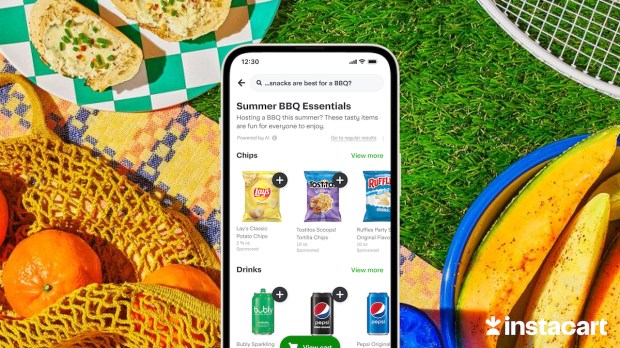Instacart Introduces ChatGPT-Integrated Discovery Tool as eGrocers Aim to Do More

To extend its role in consumers’ day-to-day food routines, Instacart is leveraging artificial intelligence (AI) to offer consumers meal planning tools and other inspiration-finding capabilities.
The online grocery giant announced Wednesday (May 31) that it is combining its own AI and data with OpenAI’s ChatGPT technology to roll out Ask Instacart, a search feature designed to provide suggestions and answers to questions. The feature will be available nationwide in the weeks ahead.
“[W]ith the rapid innovation in generative AI, we believe we can create new personalized, inspirational, value-driven shopping experiences that enrich peoples’ relationship with food and how they engage with the retailers and brands they love,” Instacart Chief Architect JJ Zhuang wrote in the blog post announcing the rollout. “Today, we’re starting to roll out Ask Instacart, a first-of-its-kind AI-powered search tool designed to assist with customers’ grocery shopping questions, … offering personalized recommendations throughout the shopping experience.”
The tool is intended to offer consumers recommendations on food pairings, suggested ingredient swaps, advice about cooking techniques, ingredient lists, different kinds of meals, information about which foods work with different dietary restrictions and more.
The news comes as technology companies compete to win consumers’ loyalty by offering them the most frictionless online grocery experience, from the point of inspiration to when the meal arrives on consumers’ tables.
For instance, in a March interview with PYMNTS, Kevin Yu, CEO of connected recipes company SideChef, noted that the grocery purchasing process is just the start of driving adoption.
“We have, as well as other companies, done a great job of making recipes online shoppable, but for us, that was never the goal,” Yu said at the time. “That’s great that you [get] a recipe and there’s a button that lets you add all that to your cart. But the reality is, I don’t just make one recipe when I cook or when I buy my ingredients. That’s not even efficient.”
He added that the company is looking to have a hand in everything from meal planning to kitchen appliances to create a more frictionless end-to-end experience.
In the same vein, earlier this year, online grocer Hungryroot, which personalizes meal plans for consumers, shared that its revenue grew by 47% year over year in 2022, with consumers increasingly seeking out food solutions that take care of more of the work for them.
Overall, online grocery companies are looking to seize the opportunity to drive adoption in the underpenetrated category. Research from PYMNTS’ study “Digital Economy Payments: The Ascent of Digital Wallets,” which drew from a survey of more than 2,700 U.S. consumers about their shopping habits, noted that online grocery adoption is less than half that of online non-grocery retail. Plus, in terms of dollars spent, the latter outpaces grocery by a factor of six.
However, adoption has come a long way. According to data from PYMNTS’ study “Changes in Grocery Shopping Habits and Perception,” which drew from a December survey of more than 2,400 U.S. consumers, nearly half of all shoppers now purchase groceries online at least some of the time. Plus, the share that buys groceries exclusively via eCommerce channels (7.2%) has grown 36-fold since before the pandemic.

